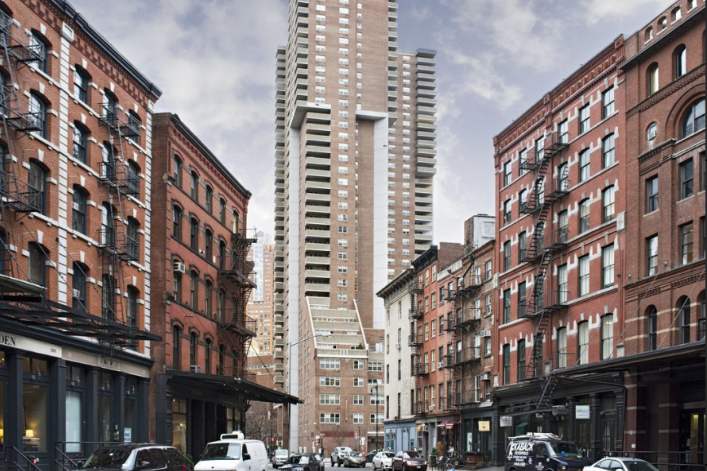Ask Sam: What happens when a rental building leaves the Mitchell-Lama program?

Independence Plaza North in Tribeca, a former Mitchell-Lama building that exited the program but still offers affordable rents
I live in a Mitchell-Lama rental building, and we just heard that our landlord is applying to leave the program. What exactly does that mean? What will happen now and what should we do?
Forming a tenants’ association is key to reaching a favorable agreement with your landlord, says Sam Himmelstein, a lawyer at Himmelstein, McConnell, Gribben, Donoghue & Joseph, who represents residential, commercial tenants, and tenant associations.
“As a united group, you’ll be more powerful in dealing with the landlord,” Himmelstein says. “It also makes hiring an attorney infinitely more affordable because you’re pooling resources.”
The Mitchell-Lama program, created in 1955 as part of a push for urban renewal, produced affordable rentals and co-ops for middle-income New Yorkers. Some Mitchell-Lama developments are supervised by the State Division of Housing and Community Renewal, while others are overseen by the City Department of Housing Preservation and Development.
“Both the DHCR and HPD have regulations that provide for how a building can properly come out of Mitchell-Lama and what sort of steps they need to take to do so,” explains Serge Joseph, a partner with Himmelstein, McConnell, Gribben, Donoghue & Joseph.
These regulations include requiring the landlord to give tenants 365 days’ notice of intent to leave the Mitchell-Lama program, via mail and postings in the management office and other conspicuous places in the building.
There are several issues that can arise when a rental building leaves Mitchell-Lama, including the question of what the legal rent will be. Under rent stabilization law, if the building was built before 1974, when it exits Mitchell-Lama, it must enter the rent stabilization program, and the rent remains the same as it was before.
“Tenants want to make sure of what the last rent under Mitchell-Lama is, and to resolve whatever rent issues they may have,” Joseph says. “Otherwise, temporary surcharges and improper rent calculations may become permanent, so make sure the initial stabilized rent doesn’t include those.”
Another issue is what services—like a gym, outdoor space, laundry facilities, and parking—tenants will receive once the building leaves Mitchell Lama and enters rent stabilization. Under rent stabilization law, those services become permanent and required rent stabilized services.
“Landlords may try to curtail those services before the building comes out of Mitchell-Lama, or permanently provide them at a higher cost,” Joseph says. “Don’t permit your landlord to mess around with services that are required under Mitchell-Lama, and thus must be provided under rent stabilization.”
Tenants should also watch out for a landlord who stops offering services to people on the waiting list, whether for an apartment or a parking space, before the building leaves Mitchell-Lama. Otherwise, some landlords may try to warehouse apartments or withhold an amenity like a parking space that becomes available.
Finally, tenants should look closely at the regulatory agreement for their buildings and make sure the landlord is following it.
“Many of the deeds for developments contain restrictive covenants, and some of these covenants may be even more favorable to tenants than the Mitchell-Lama law,” Joseph says. “For instance, some the building has to remain affordable for 50 years, or forever. Tenants should hire an attorney to review these covenants and make sure they do not contain additional rights.”
All this applies to buildings that were constructed before January 1, 1974, but for those built after, tenants still may be able to secure affordable rents even after the building leaves Mitchell-Lama program, through the Landlord Assisted Program agreement.
“LAP agreements grant some protected status to people in occupancy—they can stay in the apartment and have moderate rent increases,” Himmelstein says. “But as those apartments become vacant, the next tenants don’t have any protections. Most of the post-1974 construction buildings that have left Mitchell-Lama have entered into LAP agreements.”
Forming a tenants’ association and hiring an attorney with experience in Mitchell-Lama cases is the best way to protect yourself and your fellow renters, when your building leaves the Mitchell-Lama program.
Related:
Good news: The new rent laws just made it easier to challenge your rent stabilization status (sponsored)
Ask Sam: What are the rules for succession in Mitchell-Lama housing? (sponsored)
Ask Sam: How do I start a tenants association? (sponsored)
Read all our Ask a Renters Rights Lawyer columns here.
Sam Himmelstein, Esq. represents NYC tenants and tenant associations in disputes over evictions, rent increases, rental conversions, rent stabilization law, lease buyouts, and many other issues. He is a partner at Himmelstein, McConnell, Gribben, Donoghue & Joseph in Manhattan. To submit a question for this column, click here. To ask about a legal consultation, email Sam or call (212) 349-3000.

























